Teach ‘Launch Angle’ Youth Baseball & Softball Swing In 2022? How To Fix Bat Path, Drag, Training Drills, & What Is Optimal?
Baseball Swing Trainer: ‘Swinging Down’ In ‘Launch Angle’ Era?
Should parents, coaches, and instructors be teaching the ‘launch angle’ swing to youth baseball and softball players in 2022? You’ll learn simple drill cues to fix bat path issues, bat drag, and what is an optimal launch angle?
Typical baseball swing trainer BEWARE!
I agree with ‘swing down’. Let that sink in for a bit. Some are pissed I just said that. But those who’ve followed me for some time are nodding their head in confirmation because when you know, you know.
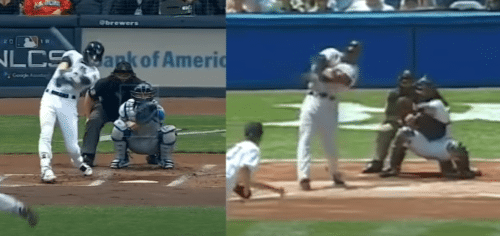
Christian Yelich and Barry Bonds swing comparison. Photo courtesy: Jomboy Media YouTube channel
Because guess what? It depends. ‘Swing down’ shouldn’t be used as a baseball swing trainer blanket teach. The above Christian Yelich video says baseball swing trainer Barry Bonds taught him a drill that changed his career…
I have two things for you…
- Jomboy Media VIDEO: “Christian Yelich says Barry Bonds taught him a drill that changed his career” (watching it will reveal its relevance to this post), and
- Below is Chapter-2 of the new book I’m working on. It’s a longer post, but I think you’ll like it. Goes well with the Yelich-Bonds video above, like grass fed red meat and a fine red wine.
Thank you Grandpa Mike for sharing the baseball swing trainer video. You know who you are. Enjoy!
SCIENCE-BASED TRAINING:
Improve your hitting strategy dramatically by applying human movement principles.
Learn not only how and what to train but also the science behind the methods.
———-
WHAT AN OLD SCHOOL SWING FEELS LIKE & THE PROS AND CONS?
In Chapter-2, we’ll look at what an old school swing feels like and the pros and cons. We’ll be discussing:
- How can someone tell Mike Trout, Albert Pujols, or Alex Rodriguez what they say about hitting is wrong?
- Pros to old school feel mechanics,
- Cons to old school feel mechanics, and
- So, how do we interweave brainless data and confusing real v. feel hitting cues?
How Can Someone tell Mike Trout, Albert Pujols, or Alex Rodriguez what they Say about Hitting is Wrong?
Now, some of you out there have seen the video of Alex Rodriguez demonstrating how he swung down. Maybe you saw the preseason interview of Mike Trout discussing how he gets on top of the ball.
Or how about Albert Pujols on the MLB Network revealed he swings knob down to the ball?
‘Swing down’. ‘Getting on top of the ball’. ‘Knob to the ball’. ‘Keep barrel above hands’ is another one. Nowadays, these are some of THE most despised baseball swing trainer hitting coaching cues on the market. I was one of them. “Was”. About 2-3 years ago. Now I have a different perspective and approach. These cues DO work. But it depends on the case. And if reading or hearing those words made your blood boil…you can change too, believe me. Here’s how…
First, let’s clear up and define “swinging down”. Well yeah, the hands do go down to the ball. And depending on how high or low the ball is, the hands will go down more or less. This is true. But coaches HATE these cues for a different reason. Here’s the thing… if you watch players like A-Rod, Mike Trout, and Albert Pujols physically demonstrate what swinging down means to them, you see them using a chopping motion. Yes. The barrel and hands travel down to the ball. But not ‘hands drop’. That’s different, and is a swing flaw we MUST fix. In the high level swing, we see the barrel go down before coming up.
Here’s my beef with ‘swinging down’…
When swinging down is translated by the baseball swing trainer into a NEGATIVE attack angle. Meaning the barrel is going down towards the impact point. Is not coming up. And this is what hitting greats like Alex Rodriguez, Mike Trout, and Albert Pujols are demonstrating in interviews. And where the confusion starts. If you watch their actual swing on film, slow motion swing, what you’re going to see is a POSITIVE attack angle. Meaning, barrel elevating up to incoming ball descending down. Yes, even in Fastpitch Softball (more about this in Chapter-7). Barrel coming up to impact, positive. Barrel going down to impact, negative. We clear?
So if what these great hitters are saying and demonstrating isn’t what they’re actually doing, then what’s REALLY going on?
Well, here’s the thing … it’s the mysterious case of real versus feel. What’s really happening on video doesn’t square with what the high level hitter feels they’re doing. Two completely opposite things. Take Mike Trout. Let’s look at his real (9-year career average batted ball numbers before start of 2020 season):
- Ground-ball rate: 36.8% (League average is 43%)
- Fly-ball rate: 40.8% (League average is 37%)
- Line drive rate: 22.4% (League average is 20%), and
- Homerun to fly-ball ratio: 21.4% (League average is 9.5%).
Significantly below average ground-ball rate. Check. Slightly above average fly-ball rate. Check. Slightly above average line drive rate. Check. And well above average home-run to fly-ball ration. Checkmate! This proves his performance – the real – doesn’t jive with his feel of ‘getting on top of the ball’. I want you to go to YouTube, search “Mike Trout slow motion swing”, and watch…
His barrels goes down, then comes up to the ball. Up. Positive barrel attack angle. Not down. Not on top. Not a negative attack angle.
Before the baseball swing trainer gets upset I’m telling Mike Trout, “You know ‘nothin’!” Here’s the beautiful crazy of this whole thing. Coaches, understand this … the body is always one or two steps behind the brain. Thinking happens fast. There’s zero friction with thoughts. Nothing. It just goes, goes, goes, goes, goes. No heavy bones, muscle, organs, and fascia required to move before a thought can fire off!
The secret to unlocking the real v. feel mystery can be revealed through a psychology term called paradoxical intention…
Pros to Old School Feel Mechanics
We have to understand what Mike Trout is REALLY saying. Bring context to the numbers. Remember Chapter-1? Trout will say, “I’ll take 10 swings off the tee or during batting practice to feel like I’m getting on top of the ball”. You see, his natural tendency is to uppercut. An extreme uppercut because he uses a significant shoulder tilt to effectively feast on balls down in the zone. And this works well with pitchers targeting down in the zone, and away.
Although, this is different than the slight uppercut Ted Williams talked about in his book The Science Of Hitting. Williams talked about barrel meeting the plane of the pitch. Trout’s natural tendency runs counter to this. And what he tells himself, remember the body is one or two steps behind the brain, is to do the exact opposite of what his natural tendency is. He tells himself to get on top of the ball. And what’s the result? The barrel ends up somewhere in the middle of extreme uppercut and negative attack angle downswing. That’s what he’s trying to get for his real… to get to the middle.
The true old school baseball swing trainer hitting tragedy…
Some say hitters like Alex Rodriguez, Barry Bonds, Pujols, and Trout are – or were – fantastic at doing, but not very good at translating what they did into teaching. Take Barry Bonds. Who was the Florida Marlins hitting coach in 2016. Then they let him go. Former Marlins President David Samson said this,
“Bonds was worst hitting coach of my career.”
So why wasn’t Barry Bonds able to translate the way he hit to his prized pupils like Giancarlo Stanton? Bonds is the career Major League home run leader after all. Some say he can do, but he doesn’t know how he does what he did. I disagree these hitters aren’t good at teaching. Again it’s a translation issue.
Dr. Victor Frankl, Psychologist and survivor of four Nazi death camps, in his book Man’s Search For Meaning, calls this “paradoxical intention”. Hitters like Trout and Bonds use extreme physical cues to establish a consistent slight upward swing plane. This strategy is a “trick” played on the body, which is a step or two behind. Paradoxical intention. Take any hitter with an extreme uppercut, tell them to chop down (negative Attack Angle “feel” cue), and their barrel path ends up in a slight uppercut. Just like Ted Williams said – like magic! Feel cues are fantastic for making simple swing adjustments.
If you’re coaching youth hitters, let’s get into that world for a moment…
A lot, and I mean A LOT of youth players ages 7 to 12 years old uppercut. Extreme uppercuts. Casting. Loooong swings. They don’t need to be taught this! This is typical, before they’ve built enough strength in their bodies. In their core. In the dynamic nature of the spinal engine. They tend to cast the barrel out. Meaning, the barrel casts away from the body, leaving the back shoulder too early. This causes a long swing. Thanks to gravitational forces, centripetal and centrifugal forces*. As they swing, they end up underneath the ball. On inside pitches, they end up getting jammed a lot. And swing under a lot of pitches up in the zone. A LOT.
(*Centripetal Force is a center “seeking” force. Like twirling a rock on a string. The rock exerts force back to the two fingers holding the string. Centrifugal Force is a center “fleeing” force. Letting go of the twirling rock on a swing, causes the rock to shoot off in a tangent direction away from the original circle.)
There are other factors causing an extreme uppercut, like hands drop or constant deep barrel dumping. But with youth hitters, the rules of Physics are bigger offenders. Here’s the good news … swing an overloaded bat. Overloaded bats help young hitters build strength to do that. Regardless of mechanics. More on that protocol later in the book.
Those are the pros of an old school feel mechanics. Now, let’s look at the cons…
Cons to Old School Feel Mechanics
These are what the baseball swing trainer “metrics people” will typically bring up. You’re so out of touch. No numbers to support your gut feelings? What does that mean? How can I trust your “gut”? Because you played or coached 20 years in the Big Leagues? That’s not good enough!! What’s measurable is manageable. If you can’t use numbers to support your gut, then I’m not listening. This is a common conversation you’ve probably seen, heard, or participated in.
The old school coaching cues we just discussed in the pros to old school swing section can also be included in that gut conversation. It’s bad if the old school cues are used as a default. In a one size fits all way. For example, Johnny’s coach sees Pujols demonstrate a chopping down swing on MLB Network’s Diamond Demos. That coach goes to Johnny’s 10 year old team practice on Monday evening, and tells every one of his hitters to swing like Pujols does. Chop, chop, chop. And he tells them with the conviction, vigor, and energy of a Sunday Pastor, that they can hit like Pujols. How can you argue with Senor Alberto? From his lips to coach’s ears out of coaches mouth to kids’ ears. If Albert Pujols said it and it worked for him, then we MUST take the message literally! He is Prince Albert for jimminies sake!
Here’s the problem with that. Remember when I mentioned the translation issue? By feeding the ‘swing down’ or ‘chop down’ mantras as a default hitting strategy to every 10 year old on your team, I’m sorry to say it, but you will lose. Let me illustrate with a thought experiment…
Apply the “one-third rule” to your team. In this example, assume a third of your hitters pop the ball up a majority of the time. Another third of hitters hit line drives a majority of the time. And the remaining third are majority ground-ball hitters. So, what if you tell the whole team to swing down or get on top of the ball? A blanket statement to all. Default old school baseball swing trainer hitting cue. What do you think is going to happen?
Based on what was discussed with Dr. Victor Frankl’s paradoxical intention – remember extreme uppercut, tell them to ‘get on top’, and they end up in the middle? Slight uppercut. Inline with incoming pitch. Here’s what will happen to our team if we tell all to chop down … a third of the team that used to pop the ball up a majority of the time, will hit more line drives. Those middle third hitting line drives a majority of the time, are going to hit more ground-balls. And the ground-ball a majority of the time group, are going to hit even more worm burner ground-balls. So how did the thought experiment turn out with a blanket statement old school hitting cue?
The only group on the team that benefits are the beginning fly ball hitters. The ones hitting fly-balls a majority of the time. Those are the only ones you’ll see a significant difference, for the better. Look ground-balls are great. Especially hard ones when the defense can’t play catch. But what happens when they can play catch? When would your team come across a team that can play catch? That’s right! In all-stars. In playoff and championship games. Not good if you just converted line drive hitters into ground-ball hitters. And ground-ballers into hitting more worm burners. Read our infamous Ground-ball Rant post.
Now, let’s cook up a different scenario. A more simple yet elegant solution. Instead of giving a blanket statement, a blanket swing down, chop down to the whole team. But instead, I let the line drive hitters do their thing. Just keep doing what you’re doing. I took the fly ball hitter and told them to swing down, chop down. And I instructed the ground-ballers to hit the ball in the air. Like pop the ball up instruction. How do you think that baseball swing trainer thought experiment would go?
If I did that…now my pop-fliers AND ground-ballers are both hitting more line drives. Remember Victor Frankl’s Man’s Search For Meaning paradoxical intention? Overall, my whole team is hitting more line drives. Now my line drivers aren’t lonely. They have more competition to deal with. Competition makes everyone better. Hungrier. Especially when they’re experiencing success. Does that make sense?
The cons of an old school swing are when we apply a blanket statement shared by one of the best hitters on the planet. Don’t do that. Bad coach. You DO NOT pass go, and you DO NOT collect $200.
One swing fits all cues are a bad. And you wouldn’t know this without data to measure and optimize. Gut feelings and hunches are like throwing darts in the dark. It’s like shooting an arrow and calling whatever you hit – after the fact. It’s guessing. If you aren’t collecting numbers using a PocketRadar, Rhapsodo
, HitTrax, BlastMotion
, or SwingTracker
, then you’re flying blind. You aren’t going to know. And those hunches will just be hunches.
Same goes for blindly following what a Hall of Famer or future Hall of Famer says or said about hitting. Become a scientist. Test, test, test. Blindly following a leader without question, will make you nothing more than a sheep. Question, question, question. Even question me and EVERYTHING in this book.
So far in Chapter-2, we talked about:
- How can someone tell Mike Trout, Albert Pujols, or Alex Rodriguez what they say about hitting is wrong?
- Pros to old school feel mechanics, and
- Cons to old school feel mechanics…
We talked about how what’s real and what’s feel are two totally different things. The scenery can be very confusing. The waters choppy. How does a coach cut through the clutter and calm the waters? The simple truth to make hitting easier – it’s not easy, but we can make it easier – is called paradoxical intention. Doing the exact opposite of what just happened to get the middle. Extreme swing up? Tell them to swing down – hit a chopper. Extreme swing down? Tell them to swing up – hit a pop-fly. There’s more to it of course, and we’ll get into it more later. Let’s move on to…
How do we Interweave Brainless Data and Confusing Hitting Cues?
This DOES NOT cause that, and that DOES NOT cause this. Question: Coincidentally, if I wear a green shirt and it rains, then is it reasonable to think I can make it rain by wearing a green shirt? This is the exact dilemma many instructors find themselves in with what they teach.
Some teach ONLY using data. Some teach ONLY using old school hitting cues. Some claim to base their teachings on millions of hours watching ONLY the best hitters. Some validate Science with their hitting theories (proudly saying their system can’t be found in Science!!). And others validate their hitting philosophy with Science, which is what we do. Who’s right? Who’s wrong? Can we use a mix? And if so, how do we know if we’re on the right track?
Are you throwing dynamite in the air and expecting rain?
I want to share a true story from the book Dust Bowl: An Illustrated History by K
Right before the Great Depression hit the Oklahoma panhandle, rain was plentiful. This caused Doctors and Lawyers to quit their practices and join the ranks of farmers to buy land and plant crops that were being subsidized by the US government. In other words, the gold-in-them-hills was harvesting and selling wheat and other bumper crops of the era.
Millions of acres of 6-foot high beautiful Buffalo blue grass were plowed under to make room for crops. Fast forward to the beginning of the Great Depression, the rain dried up, and so did the crops. Unbeknownst to the “new” farmers who moved to the area, typically rain was sparse in the location, and by coincidence, they had just experienced a rare wet 5-10 year period.
Now there’s NO rain. And you know the 6-foot high beautiful Buffalo blue grass they cut down? Well, it used to hold the soil down despite seasonal 60 to 70 mile-per-hour wind gusts. So NO rain coming. NO crops growing. Super high winds are eroding dry barren soil and tossing it up in the air. Grazing cattle have nothing to eat but tumbleweeds brought over by Russians (people often sprinkled salt to eat them as well). The livestock soon get sick and die. The drought is fatal for the majority who stay, others move west. This is where we get John Steinbeck’s book “Dust Bowl”.
Stick with me, because here comes the lesson…
The farmers who stayed behind were so desperate for rain, they hired self proclaimed rain experts to “create” rain, literally out of thin air. The belief at the time was that an explosion in the air could bring clouds, and with clouds, rain would fall from the sky. In plenty. So what did these self proclaimed rain experts do? What any self proclaimed rain expert would do!! They sold the idea that if they lit a stick of dynamite, timed the throw just right, they could get a perfectly timed explosion that would bring rain-a-plenty.
…And as luck would find it, the “racket” seemed to work a couple times. This only fed the foolishness we all see now – hindsight is 20/20. Yes, this wasn’t a proud time in American history. You have to understand, people back then were DESPERATE. Their hope blinded them to the MANY times throwing dynamite in the air didn’t work. People lost limbs, fingers, etc. from timing the throw wrong. Head scratcher I know.
When it comes to baseball swing trainer, we have to be careful of the causation-correlation relationship. Is studying video and teaching only what the “best” hitters are doing enough? I would argue it is not. How do you know what you’re looking at, if you don’t know what you’re looking for? We see Pujols demonstrating a negative attack angle swing on MLB Network. But then we see him NOT do that in real-time. We bring that same Pujols gold nugget to Johnny’s team, blanket teach it, and the end result looks nothing like what we see Pujols do during competition. This DOES NOT cause that, and that DOES NOT cause this.
I’m going to reveal a secret about why coaches are terrible at the causation-correlation relationship. Like shooting a random arrow and calling whatever is hit. Here’s a quote summing it up from Loserthink: How Untrained Brains Are Ruining America:
“There are three important things to know about human beings in order to understand why we do the things we do. [1] Humans use pattern recognition to understand their world. [2] Humans are very bad at pattern recognition. [3] And they don’t know it.”
So how do we escape this seemingly inescapable prison of baseball swing trainer misdiagnosis? After reading thus far, you know it. Be less subjective and more objective. KeyDifferences.com says this about subjective versus objective:
“Subjective means something which does not show the clear picture or it is just a person’s outlook or expression of opinion. A subjective statement relies on assumptions, beliefs, opinions and influenced by emotions and personal feelings. An objective statement is based on facts and observations.”
Use the Scientific Method. Develop a hitting Question…make a predictive Hypothesis…do the Research…collect the Data…form a Conclusion. Swing experimentation. We apply human movement principles validated by REAL Science to hitting a ball. Scientific principles pulled from:
- Physics,
- Engineering,
- Biomechanics, and
- Body work.
How do we figure out if this DOES cause that? Or if that DOES cause this? Not by wearing a green shirt! To know what you’re looking at, you have to know what you’re looking for. DO NOT validate Science through your hitting philosophy. DO validate your hitting philosophy through Science. Set a higher standard for your hitters. It’s okay – watch your millions of hours of video…employ those expensive measuring gadgets…and flaunt those old school hitting cues.
But above ALL of that … understand what the rules to human movements are FIRST. Once you know that, all other domino’s fall where they’re supposed to. In conclusion of Chapter-2, we looked at what an old school swing feels like and the pros and cons. We discussed:
- How can someone tell Mike Trout, Albert Pujols, or Alex Rodriguez what they say about hitting is wrong?
- Pros to old school feel mechanics,
- Cons to old school feel mechanics, and
- So, how do we interweave brainless data and confusing real v. feel hitting cues?
In Chapter-3, we’ll answer the question of what leads to hitting more predictable line drives and less strikeouts. Where we’ll dive into:
- What does “predictable” mean and why does probability matter? And,
- Difference between ‘Launch Angle’ and ‘Attack Angle’…
Onward…
———-
- Best Hitting Drills for 8-Year-Olds (2025): Fix Swing Flaws Fast with This MLB-Trusted Youth Baseball System—At-Home, Step-by-Step, and Built for Game-Day Confidence - July 5, 2025
- Best Youth Baseball Hitting Program to Boost Rotational Power Fast—Trusted by MLB’s Rajai Davis & Built on the Catapult Loading System - June 22, 2025
- The #1 Arm Care Program for Youth Baseball: Why Top Travel Coaches Trust Jaeger’s J-Bands & Long Toss Routine to Prevent Injury Fast - June 3, 2025

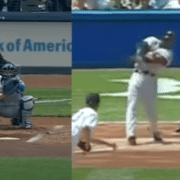



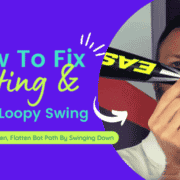
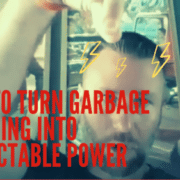

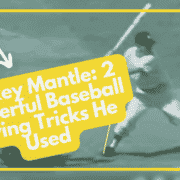
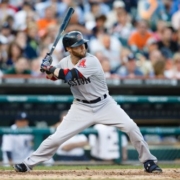



Great job, Joey. Exactly. The concept of paradoxical intention makes the most sense in solving this problem of real vs feel, old school vs new school. The context you put it in makes the most sense and should end the debate. After all, it’s not what you say to do but what you say to do under what circumstances. Maybe the Orioles Chris Davis should practice swinging down.
Thanks Joe. Yes I agree about Davis. He could take away a lot from what Barry Bonds told Yelich.
The bro-scientists out there could use some paradoxical intention. Your article should end the argument between old school vs new school, but somehow I don’t think so.
C’mon Joe! the 40yo male ego is fragile. They fight with emotion, not with logic. The more and more they get beat up on the field, the closer they get to submission. Unfortunately, that’s how they’ll eventually come around.
What the bro-scientists don’t understand is that “new school” is really “old school” (Shoeless Joe, Babe Ruth, Ted Williams, etc). Their version of “old school” was once “new school” (Charlie Lau, Walt Hriniak, Tony Gwynn). Does that make sense?
Absolutely. That’s the beauty of validating hitting philosophy with Science. There is no such thing as old or new school. Only those who use their opinions on hitting to validate Science. The world doesn’t work this way.
So, it is safe to say that the old guys -Ruth, DiMaggio, Williams, Mantle, Aaron, etc – were much more compliant with human movement science than the guys between them and today’s hitters – Soto, Donaldson, Turner, Yelich, etc. “New school” is really “old school” or “old, old school.” Lol, you just have to be around long enough to know that, either that or a good historian.
Bingo Joe!
So, whatever happened between then and now? It’s a total head scratcher.
lol, indeed. The availability of information (internet – a ton of it) has emboldened many, giving them a false sense of knowledge. Who you follow matters. What information you follow matters.
Though there’s a lot of crazy stuff on the internet, I was really referring to the late 1970s to around 2000, the Lau/Hriniak period and the Dusty Baker book, YOU CAN TEACH HITTING (1993). Baker’s book, and videos, taught “squishing the bug,” the first I saw that taught. Baker hit behind Hank Aaron and didn’t “squish the bug!” Principles first, then methods – it’s the only thing that makes sense.
Amen Joe!
Joey,
Ah, yes, “the squish the bug” phenomenon and the battles I had with parents and kids, who were taught that nonsense by incompetent and shady hitting instructors, who just took the path of least resistance.
Now, we got the always amusing battle between Jeff Frye and She Gone Nation and Teacherman. Frye is a good dude and a hard nosed competitor but he can’t, or won’t, explain the components of the swing. Teacherman, who rose to prominence because of Aaron Judge’s 2017 season, won’t allow anyone to disagree with him and only the instructors that he teaches know hitting. In studying Judge’s swing, comparing his swing in 2017, when he burst on the scene, with that of 2016, when he floundered, I can’t see that much of a difference except for a modification of his leg kick. What did Teacherman change in Judge’s swing between 2016 and 2017? It is difficult to tell. It has led me to conclude that it is not that Teacherman taught Judge a swing insomuch as Judge taught Teacherman the swing that Teacherman demonstrates on YouTube. And, Teacherman said that he copied Barry Bonds’ swing? Bonds’ didn’t hit like Teacherman in those videos on YouTube! I guess it’s a buyer beware situation. Mickey Mantle warned hitters to “take as little coaching as possible.’. I’d watch Mantle hit and try to copy it if I were a kid. Principles first!
Joe, you raise some very validated objections. I do agree with Teacherman on one thing…his approach is effective middle away and middle down. It’s terrible for middle in and middle up in the zone. His attitude is much to be desired. By the way, his son (the agent) put Judge in front of him. It wasn’t Judge who sought out TM. Big difference. TM got lucky. He’s been peddling the same stuff for almost 3 decades. Most of the people that reach out to me, who used to follow him – and were good buddies at one time, all say he’s a living breathing contradiction. It’s all a con.
Joey,
I thought it was David Matranga of PSI Sports Management who got Teacherman to work with Judge. Middle up and middle away works but not up and in or low and in. But Judge’s weakness is low and away, particularly sliders. Miss away to Judge and it’s in the short porch in right center at Yankee Stadium.
My issue with Teacherman is no bend in the front knee. No bend in Judge’s front knee either. Doesn’t get on plane for those low breaking balls. Couldn’t detect much of a change in Judge’s swing from pre-TM in 2016 and post-TM in 2017 other than reducing his leg kick.
Hard to condone TM’s behavior as made clear with his showdown with Jeff Frye on Dan Blewitt’s podcast on YouTube and Twitter comments afterwards, blocking Blewitt from responding. Simply childish. I stick with my contention that TM teaches how Judge swings not the other way around.
You know my thoughts on this Joe. Great observations as always my friend.